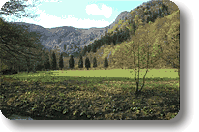 |
A VR node allows the creation of a 360 degree virtual reality panorama of any kind, starting from simple 24x36 slides captured around a single point of rotation.
A VR node integrated to a web site is thus an effective and cheap system to virtually view any kind of environment, both indoors and outdoors, also at thousands of kilometers away.
The easy software allowing its view with any kind of computer is QuickTime VR by Apple, which can be freely downloaded from the official web site both for Macintosh and Windows.
However, the software necessary for the creation of the VR node is one of the most complex, and it is essential to be equipped with a powerful hardware in order to merge the photographic shots into a single panoramic Pict.
The experience of any amateur photographer will make it easy to take these shots by using a normal equipment and following some simple instructions:
1. Equipment
- camera reflex 24x36 mm
- 28 mm. lens
- tripod
- level
- 36-exposure film, slides 100 asa
2. The choice of the shooting place
- you can shoot outdoors or indoors without distinction, in a panoramic position or within a shelter (if you are indoors, try to place yourself in the middle of the room).
3. Lighting
- if you are outdoors, take the shots only if the sun is already high, so that it will not enter the camera; if you are indoors, consider a longer exposure time, since strong underexposures do not guarantee enough visual information for a correct creation of the VR node.
4. Leveling the camera
- place the reflex in a vertical position, so that you can best exploit the shooting field of the 28 mm. lens up and down; then check the absence of swinging on the horizontal level with a complete rotation of the camera, with a good leveling (level the reflex only after installing it vertically on the tripod: often the vertical rotation of the head of the tripod, already horizontally leveled, nullifies the previous work - in these cases you can use the self-sticking levels, which you can buy without spending too much, and place them on the camera and/or on the lens)
5. The number of shots to take
- a 28 mm. lens on a vertically placed reflex gives the possibility to cover the 360 shooting degrees with 18 shots (20 degrees for each shot).
6. The rotation sense
- The sequence of 18 original shots must strictly be taken in a clockwise direction.
7. The first shot
- choose the first of the 18 shots of the sequence by considering that, once you have created it, the VR node will open exactly with that first frame.
8. Shooting movements
- After the first shot, use the graduated notches of the tripod to identify the 20-degree rotation necessary for each shot, and then use it for each following shooting movement (do not worry about the overlapping shooting points between the shots, but be sure that you are following the graduated reference points, which will guarantee you a correct closure of the 360 degree sequence).
9. The correct exposure
- each of the 18 shots must be taken in normal exposure conditions, and therefore each of them can have a different shooting time (very closed diaphragms guarantee a better depth of field).
10. After the development of the film roll
- check that the slides are correctly exposed and focused (a malfunction during a single shot nullifies a whole sequence!) and that the leveling of the reflex has been correctly carried out (for an empirical check, place the 18 slides on a table and overlap them in the shooting areas they have in common: they must be in line and not have a sinusoidal pattern)
11. Recording the slide sequences on a Photo CD
- after you have checked each slide and have numbered them from 1 to 18, (from 19 to 36, from 37 to 54 and so on for eventual following sequences) bring them to a photographer's shop and ask him to record them on a 100 slide Photo CD, in the same sequence indicated by the numbers (be careful the lab places all the slides of the sequence in a consistent manner, avoiding to turn some of them upside down).
At the end of the operation (usually two/three days) the lab will give you back the original slides, which you can preserve, and the Photo CD, which you can send us for the further processing necessary to the online publication.
ComunicAzione - online publications
technical manager of the Italian Park Portal www.parks.it
via Golfarelli, 90 - 47100 Forlì
tel 0543/798880 fax 0543/798898
E-mail: comunic.azione@comunic.it |

